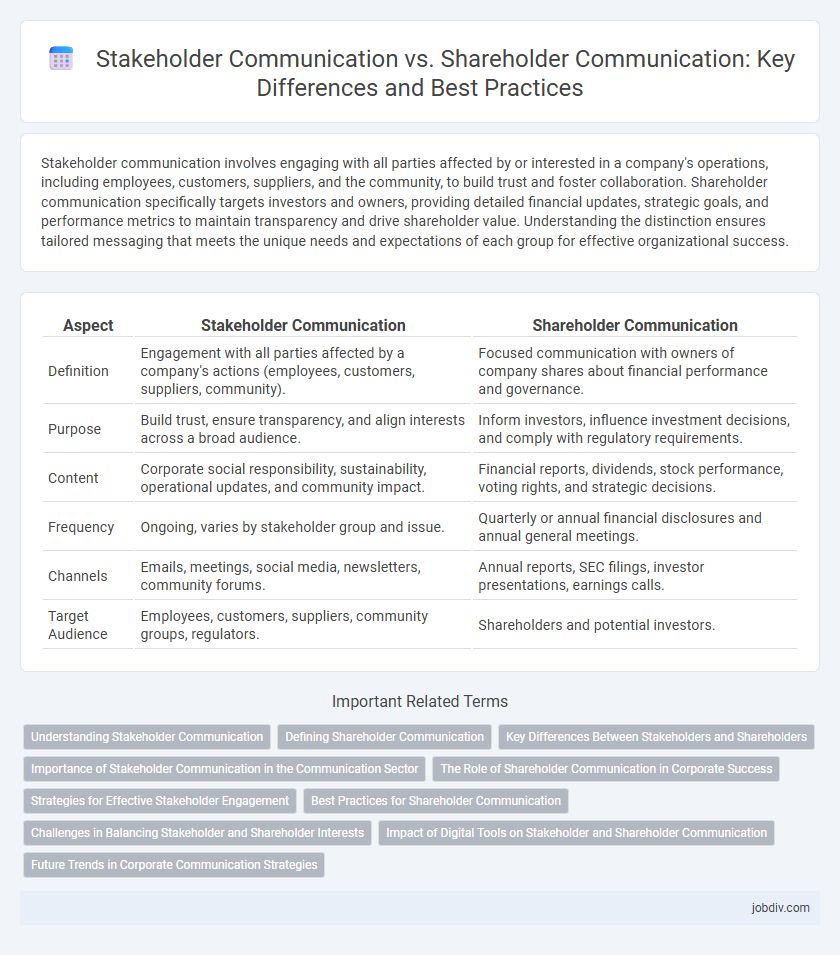Stakeholder communication involves engaging with all parties affected by or interested in a company's operations, including employees, customers, suppliers, and the community, to build trust and foster collaboration. Shareholder communication specifically targets investors and owners, providing detailed financial updates, strategic goals, and performance metrics to maintain transparency and drive shareholder value. Understanding the distinction ensures tailored messaging that meets the unique needs and expectations of each group for effective organizational success.
Table of Comparison
| Aspect | Stakeholder Communication | Shareholder Communication |
|---|---|---|
| Definition | Engagement with all parties affected by a company's actions (employees, customers, suppliers, community). | Focused communication with owners of company shares about financial performance and governance. |
| Purpose | Build trust, ensure transparency, and align interests across a broad audience. | Inform investors, influence investment decisions, and comply with regulatory requirements. |
| Content | Corporate social responsibility, sustainability, operational updates, and community impact. | Financial reports, dividends, stock performance, voting rights, and strategic decisions. |
| Frequency | Ongoing, varies by stakeholder group and issue. | Quarterly or annual financial disclosures and annual general meetings. |
| Channels | Emails, meetings, social media, newsletters, community forums. | Annual reports, SEC filings, investor presentations, earnings calls. |
| Target Audience | Employees, customers, suppliers, community groups, regulators. | Shareholders and potential investors. |
Understanding Stakeholder Communication
Stakeholder communication involves engaging a diverse group including employees, customers, suppliers, and community members, aiming for transparency and mutual benefit to foster long-term relationships. Unlike shareholder communication, which primarily focuses on financial performance and investment returns to owners, stakeholder communication addresses a broader range of interests and concerns impacting organizational sustainability. Effective stakeholder communication enhances trust, supports collaborative decision-making, and aligns organizational goals with social and environmental responsibilities.
Defining Shareholder Communication
Shareholder communication refers to the strategic exchange of information between a company and its shareholders, ensuring transparency about financial performance, corporate governance, and voting rights. This form of communication prioritizes clarity on dividends, annual reports, and shareholder meetings to uphold investor confidence and regulatory compliance. Effective shareholder communication directly influences stock value and attracts potential investors by maintaining trust and accountability.
Key Differences Between Stakeholders and Shareholders
Stakeholder communication encompasses a diverse group including employees, customers, suppliers, and community members, emphasizing broader interests beyond financial returns. Shareholder communication specifically targets investors with a focus on financial performance, dividends, and company growth metrics. Key differences lie in the scope and purpose: stakeholders require engagement on social, environmental, and operational impacts, while shareholders prioritize transparency in financial results and strategic business decisions.
Importance of Stakeholder Communication in the Communication Sector
Effective stakeholder communication in the communication sector ensures that diverse groups such as customers, employees, partners, regulators, and communities remain informed and engaged, fostering trust and collaboration. Unlike shareholder communication that targets investors primarily concerned with financial returns, stakeholder communication addresses broader interests, enhancing reputation and facilitating sustainable growth. Prioritizing stakeholder dialogue enables organizations to anticipate challenges, adapt strategies, and cultivate long-term relationships critical in a dynamic and interconnected communication landscape.
The Role of Shareholder Communication in Corporate Success
Shareholder communication plays a crucial role in corporate success by ensuring transparency, fostering investor confidence, and facilitating informed decision-making. Effective communication with shareholders helps align corporate strategies with shareholder interests, thereby enhancing trust and long-term investment commitment. Transparent disclosure of financial performance, governance practices, and future outlooks strengthens the company's market reputation and supports sustainable growth.
Strategies for Effective Stakeholder Engagement
Effective stakeholder engagement requires tailored communication strategies that address the diverse interests and concerns of various groups, including employees, customers, suppliers, and community members. Transparent, consistent messaging combined with active listening tools such as surveys and feedback sessions fosters trust and collaboration, enhancing project outcomes and corporate reputation. Leveraging digital platforms alongside traditional channels ensures timely, relevant information delivery, enabling proactive issue resolution and long-term stakeholder commitment.
Best Practices for Shareholder Communication
Effective shareholder communication prioritizes transparency by providing clear, timely financial reports and strategic updates that align with investor expectations and regulatory requirements. Regularly scheduled earnings calls and annual general meetings offer opportunities to engage shareholders directly, addressing concerns and reinforcing trust. Utilizing digital platforms for real-time information dissemination enhances accessibility and ensures investors remain informed about company performance and governance.
Challenges in Balancing Stakeholder and Shareholder Interests
Balancing stakeholder and shareholder interests presents challenges such as aligning diverse expectations while maintaining company profitability. Stakeholders often prioritize long-term social and environmental impact, whereas shareholders focus on short-term financial returns. Effective communication must address these conflicting priorities through transparent dialogue and strategic compromise.
Impact of Digital Tools on Stakeholder and Shareholder Communication
Digital tools have transformed stakeholder communication by enabling real-time, interactive engagement across diverse platforms, enhancing transparency and collaboration among customers, employees, suppliers, and communities. For shareholder communication, technologies like virtual annual meetings, digital reporting, and AI-driven analytics facilitate timely dissemination of financial data and personalized investor relations, improving shareholder confidence and decision-making. These digital advancements reduce communication gaps and increase responsiveness, driving more effective stakeholder and shareholder relationships.
Future Trends in Corporate Communication Strategies
Emerging trends in corporate communication emphasize personalized, transparent stakeholder engagement over one-dimensional shareholder updates, leveraging AI-driven analytics to tailor messages based on stakeholder interests and behaviors. Companies increasingly integrate digital platforms and social media to facilitate real-time, bi-directional communication, enhancing trust and fostering long-term relationships with diverse stakeholder groups. The future landscape prioritizes sustainability and ethical narratives, aligning communication strategies with evolving regulatory expectations and global socio-economic changes.
Stakeholder Communication vs Shareholder Communication Infographic

 jobdiv.com
jobdiv.com